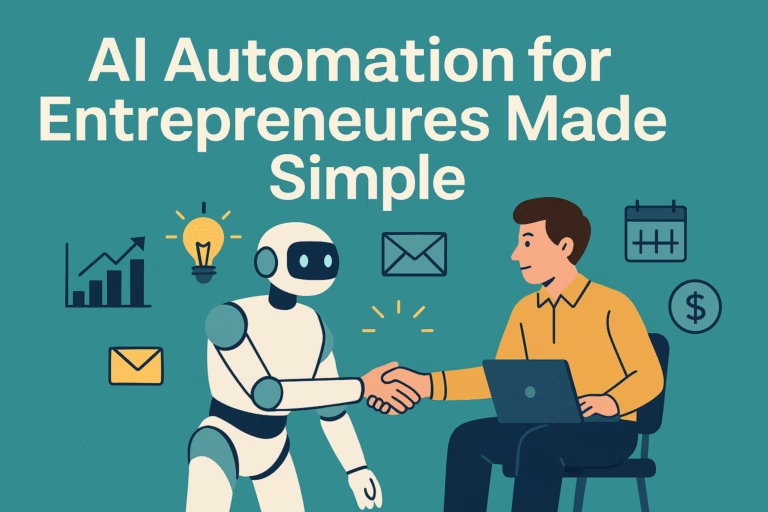The biggest myth about AI automation for entrepreneurs is that more tools mean more power. In reality, every extra tool adds friction — another login, another workflow, another thing to fix when it breaks.
The best systems are boring in the best way. They run quietly, predictably, and without constant tinkering. That’s why many founders now lean on Blaze Autopilot — one streamlined hub that removes the noise.
Entrepreneurs burn out not because they lack ambition but because their tech stacks are overbuilt. Ten different apps for scheduling, analytics, emails, and reporting can’t talk to each other.
Time disappears into maintenance. Simplicity fixes that.
A clean automation setup does three things:
-
Handles repetitive work behind the scenes.
-
Produces measurable output on schedule.
-
Leaves you free to make high-value decisions instead of micromanaging software.
The irony is that simplicity requires discipline. You must say no to shiny new tools and build one reliable workflow that delivers results. Once that system works, scaling becomes effortless because it grows from clarity, not clutter.

The Core Framework-Plan, Automate, Review
Think of automation like a flywheel: slow at first, then unstoppable. Every founder who succeeds with AI automation for entrepreneurs follows the same three-step rhythm Plan, Automate, Review.
1. Plan
Every Monday, write down the tasks that truly drive revenue or visibility. Forget everything else for now. You can’t automate chaos, so start with your most consistent, repeatable actions.
2. Automate
Use your AI system to take those specific tasks off your plate. It could be content repurposing, client follow-ups, or report generation. Start with what you do most often, not what sounds most exciting.
3. Review
On Fridays, check what worked. Which automations saved time? Which broke or produced weak results? Delete what’s redundant, refine what’s effective, and update your prompts or rules.
This loop creates momentum. The more you refine, the smoother it gets. The result isn’t a flashy AI system it’s one that runs so naturally you forget it’s there.
Where AI Automation Delivers the Most Impact
If you want quick wins, start where the work piles up most. Every entrepreneur has bottlenecks — tasks that steal time and mental energy but don’t need your personal touch. That’s where AI automation for entrepreneurs changes everything.
Here’s where it delivers the most leverage:
Marketing
AI tools can generate posts, captions, and newsletters in your brand’s voice. A single blog becomes social updates, emails, and short-form scripts. What used to take hours now happens in minutes.
Sales
AI can qualify leads, reply to inquiries, and send follow-ups automatically. You stay focused on closing deals instead of chasing replies. Lead response time becomes instant, which directly improves conversions.
Customer Experience
Smart chat systems handle FAQs, appointment scheduling, and order updates. Customers get 24/7 service without waiting, and you maintain the human tone you trained your AI to use.
Operations
Automation now builds reports, tracks projects, and alerts you before deadlines slip. You spend less time gathering data and more time interpreting it.
You can think of automation as a time amplifier. Each task may save five minutes, but multiplied across hundreds of interactions a week, the result is entire workdays reclaimed.
The 80/20 Setup Blueprint
Automation gets powerful fast, but you don’t need to overhaul your business to benefit. The smartest founders focus on the 20 percent of automation that produces 80 percent of the gains. Here’s how to do it without overwhelm.
Step 1. Identify your top three time drains.
Look for repetitive, rule-based tasks: posting, replying, reporting, or scheduling. If it happens every week, it can be automated.
Step 2. Connect them to one central hub.
Instead of linking five different apps, use a single system that handles content, analytics, and communication together. Simplicity ensures reliability.
Step 3. Run a one-week test.
Don’t plan endlessly — act. Run automations for seven days and record how much time you save or what output improves.
Step 4. Refine and scale.
If it saves measurable time, keep it. If it causes friction, remove it. Then expand into one new area at a time.
By the end of the month, you’ll have a simple, data-backed system that grows smoothly without collapsing under complexity. Automation doesn’t need to look impressive to work — it just needs to be dependable.
The Role of Blaze Autopilot
There’s a difference between automation that saves minutes and automation that transforms a business. Blaze Autopilot sits firmly in that second category. It embodies what clean AI automation for entrepreneurs should look like — one login, one dashboard, and zero chaos.
Instead of bouncing between design tools, schedulers, and analytics apps, Blaze Autopilot ties everything together. You write once, it adapts for every channel, posts on schedule, and reports back with engagement data that actually makes sense. It doesn’t overwhelm you with features; it quietly gets things done.
That’s what simplicity feels like in 2025 — focus without friction. Entrepreneurs use Blaze to plan their week, publish across platforms, and watch performance analytics evolve automatically. The system acts as a silent teammate, not another to-do list.
For small teams, it’s scale. For solo founders, it’s sanity. You spend your creative energy on ideas instead of integration. And that’s exactly why tools like Blaze Autopilot are defining how modern businesses grow.
Common Mistakes When “Simplifying”
Simplicity sounds easy until you try it. Many entrepreneurs sabotage their systems while chasing it. These are the most common pitfalls to avoid when implementing AI automation for entrepreneurs.
1. Removing too much human oversight
Automation doesn’t mean abandoning judgment. Every system still needs a human to review tone, accuracy, and results. Without that, errors multiply faster than you can catch them.
2. Automating before documenting
If your process is vague, AI can’t follow it. Write down each step first — how you post, reply, or deliver — then automate from that template. It prevents confusion later.
3. Ignoring performance data
You can’t improve what you don’t measure. Set a few clear metrics — time saved, engagement, or conversions — and check them weekly. Automation without data is just noise.
4. Over-adding tools
In the name of efficiency, many founders pile on integrations that break their workflow. Keep it lean. If a tool doesn’t clearly save time or add insight, it doesn’t belong.
Simplicity is a discipline, not an accident. The founders who master it know exactly what to keep, what to cut, and what to automate — and that clarity is their edge.
Metrics That Prove It’s Working
When you start using AI automation for entrepreneurs, it’s easy to get caught up in how cool it feels. But “feeling efficient” doesn’t always mean progress. The real test is in the data — what changes when your systems take over.
Here’s how to measure it simply and objectively:
| Metric | Why It Matters | Target |
|---|---|---|
| Time Saved per Task | Shows efficiency and identifies which automations pay off | At least 50% reduction in repetitive work |
| Posting Consistency | Builds audience trust and improves algorithmic reach | 100% of planned posts go live on schedule |
| Lead Response Speed | Directly impacts conversion and customer satisfaction | Replies within 5 minutes or less |
| Engagement Rate | Shows that automation maintains a human touch | Steady or improving over 30 days |
| Revenue Growth | Proves that automation supports real business results | Monthly increase in conversions or recurring revenue |
Track these once a week. When time saved and consistency rise while engagement stays stable or climbs, you know your automation isn’t just working — it’s compounding.
The best part? This data becomes the backbone for scaling. You’ll know where to invest next because your numbers tell you what’s already paying off.
Scaling Without Losing Control
After your foundation is running smoothly, expansion gets tempting. But scaling AI automation for entrepreneurs shouldn’t mean turning everything over to machines. Growth without oversight creates chaos faster than manual work ever did.
The key is controlled layering — adding one new automation at a time, only after proving the previous one delivers real value.
Start with integration.
Link your analytics, communication, and CRM tools so data flows naturally across systems.
Add one upgrade per month.
Try things like automated performance reports, AI-driven idea generation, or smart reminders for client renewals. Each should save measurable time or increase visibility.
Replace, don’t pile.
For every new tool or automation, remove one manual process. Simplicity must scale with complexity.
Review quarterly.
By revisiting results every few months, you ensure your system grows in strength, not clutter.
At scale, automation becomes less about saving minutes and more about preserving focus. You’re no longer running operations — you’re steering a machine that runs itself.


